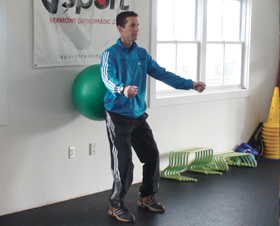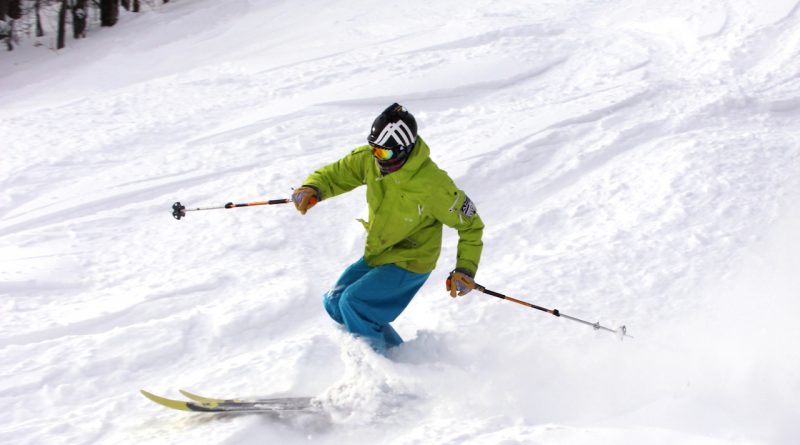Get in Shape for Skiing: Simple Training Tips

By Billie Munro Audia
A nip in the air, crunching leaves underfoot, and the need to don a fleece all mean ski season is just around the corner. It is exhilarating – at least for us passionate winter sports enthusiasts – and this season, by following a few simple training tips, you can be in snow-sport shape when you hit the slopes.
Below, you’ll find insight from top-level snow-sport coaches and instructors, exercises to target sport-specific muscles, and the four elements of snow sport conditioning: cardio endurance, strength training, plyometric exercises, and balance work – so you may incorporate them into your pre-season workout routine.
CARDIO ENDURANCE
“Recreational skiers may easily increase their on-the-snow performance by maintaining a regular cardio fitness routine in the off-season,” advises Bill Reichelt, head alpine ski coach at the University of Vermont. “Activities such as hiking, playing soccer, or cycling on a regular basis increase an athlete’s endurance levels, which will improve any skier’s performance,” Bill says. His advice is simple: “Be active: get out and do stuff during the pre-season.”
Cycling seems to be a popular choice for many skiers and riders who want to maintain cardio fitness. Paul Borghini, a PSIA Level 3 ski instructor at Okemo Mountain Resort in Ludlow, suggests, “A good way to keep fit during the summer is to get on a bike and ride. Fast.” The endurance training and leg strengthening that cycling promotes will bode skiers well when they hit the slopes.
As with any cardio program, the key is to increase duration and intensity gradually so you build up your endurance in a paced manner. “The preferred cardio-building activities for snow-sport athletes are Spinning and cycling, as those activities both increase cardio endurance and recruit quad and hamstring muscles,” advises Jen Muzzey, who coaches several collegiate skiers and is a master personal trainer at the River Valley Club in Lebanon, NH.
STRENGHTHENING EXERCISES
Dry-land practice is what ski teams do in the pre-season, and it includes both endurance training and strength-building exercises. One of the key strength-building drills that the UVM alpine ski team athletes do is the sled push. As Coach Reichelt confesses, “The athletes dread it during practice, but come racing season they appreciate the outcome.” He should know, as he has coached over 40 NCAA All-American skiers during his 10 years at UVM.
In the sled push drill, athletes use their lower body strength to push the weighted sled forward in an explosive burst of power. The intervals are varied to assist with lactate tolerance. This drill conditions the racer to be able to blast out of the starting gate and power down a slalom or GS course with maximum strength and minimal muscle fatigue.
As for us recreational skiers who simply want strong legs for a full day out on the slopes, there are strength-building exercises for us, too. “Recreational skiers will notice an increase in skiing performance by doing simple eccentric (muscle lengthening), isometric (muscle hold), and concentric (muscle squeezing) drills such as walking up a hill backward, which is both concentric and isometric, and walking downhill in a tuck position, which is both eccentric and isometric,” explains Bill Knowles, director of iSport Training at the Vermont Orthopedic Clinic’s sports training and sports rehabilitation center in Killington. Knowles has trained Olympian snow-sport medalists such as Hannah Kearny, Hannah Teter, and Shannon Bahrke. As he puts it, “The higher the skill level of the athlete, the more specific the conditioning needs to be,” so for the athletically minded recreational skier to see results requires less pre-season effort than for the Olympian or collegiate-level skier. Good news for us recreational skiers!
Knowles further explains, “Eccentric strength is the ability to resist forces that pull us down – forces such as gravity.” So, at the most basic level, eccentric strength allows us to walk and run, countering gravity’s force, and at its most extreme level, eccentric strength allows us to execute an explosive lift off.
Alpine racing demands the skier execute an explosive lift-off action with every turn, so eccentric training drills are a must. This is one reason Jen Muzzey incorporates power clean lifts into the training routines she develops for ski racers because, as she explains, “Power cleans specifically prepare the body for an explosive lift-off momentum, which is necessary in downhill racing.”
As Knowles attests, “The more eccentric strength you have in your lower body, the more effective you will be in resisting gravity while carving a turn.” Doing the old-stand by wall sit and wall squat exercises will improve eccentric, isometric, and concentric lower body strength and provide the weekend warrior with noticeable results.
Drills targeted specifically to improving core strength are also a key part of most snow-sport conditioning programs. To increase abdominal strength and core stability, Coach Reichelt prefers drills using medicine balls and crunches. Medicine balls are simply weighted balls that come in different sizes.
For a recreational skier with decent abdominal strength, a good core exercise is the Russian twist, where you sit on the floor with your knees bent and feet flat, hold the medicine ball out in front of you and recline back so that your body is angled in a V-shape. Then, keeping your lower body still, slowly twist your upper body to the left and gently touch the medicine ball to the floor, then do the same thing to the right, and ensure you are constantly engaging your abdominal muscles.
PLYOMETRIC EXERCISES
Pre-season plyometric exercises are also a key component of any snow-sport conditioning program, as they will improve strength, agility, and balance. Plyometrics – or plyos – are specialized, high-intensity training exercises designed to improve sport-specific strength. Plyos load a muscle with maximum force in the shortest possible time, invoking an explosive muscular contraction.
However, not all plyometric exercises are created equal. For example, jumping rope is a relatively easy plyo, while single-leg bounds up the bleachers are very challenging. Coach Reichelt has his athletes perform one-legged hops up and down bleachers and lateral bounds up and down the bleachers, which are very intense plyos.
While these types of plyos will certainly garner results for all levels of skiers and riders, more moderate plyos appropriate for a recreational skier’s pre-season routine include side-to-side hops over a stick laid on the ground (start with 2 sets of 8 to 10 reps); and lateral jumps up onto and down from a stationary box (start with 2 sets of 8 to 10 reps on each leg).
Chan Morgan, a Ford Sayre Ski Council racing coach and a former NCAA All-American ski racer also incorporates plyos into the J5 racers’ dryland training. “We keep the junior racers curious while dialing in motor skills with fun plyos and endurance work, including dry-land slalom courses, beeps testing, and obstacle course work.”
Morgan explains, “For the beeps testing drill, an athlete runs back and forth between two lines set approximately 25 yards apart, with the beep sounds indicating when they should start running in the other direction. Then, we decrease the time lag between beeps and those who don’t make it to the line before the next beep are out.”
If you are just beginning a plyometric routine, it is a good idea to start with the moderate exercises and to be sure you are landing safely, which means landing on your entire foot so you lessen joint impact, and also try to avoid any knee twisting motion.
BALANCE EXERCISES
Borghini considers skiing and riding to be all about balance, which is a skill that any athlete may improve with training. He suggests the simple exercise of standing on one foot with your eyes closed to improve balance, which is much easier said than done.
Knowles advocates using balance training equipment, such as the Vew-Do board or a BOSU balance trainer to improve balance capabilities. Improved balance immediately translates into better on-the-snow performance because maintaining balance while skiing and riding is key to falling less, and as Knowles says, “Falling less is a good thing.”
Hopefully, by incorporating these conditioning tips into your pre-season routine you will increase your endurance, strength, and balance and be able to hit the slopes in stellar shape this season.
Any recreational skier with a racing background will remember doing wall squats to strengthen quadriceps, hamstrings, and back muscles. Bill Knowles of the Vermont Orthopedic Clinic at Killington has perfected this exercise by adding the use of an exercise ball (a.k.a. Swiss ball or physioball).
The drill: Position the exercise ball between your back and the wall, assume a skiing position and slowly – within 2 to 3 seconds – squat down, while pressing against the ball, then slowly move back up to the standing position. Repeat multiple times for 30 to 60 seconds to complete one “run.” Rest for 30 to 60 seconds. Decrease the up/down time to 1 second to mimic mogul skiing. Take a healthy 8-12 runs to get started and increase to 12-16 runs just before ski season starts.
Knowles advises, “To increase the intensity of this exercise, hold a medicine ball or dumbbell in your hands or do the exercise as a single leg squat, alternating legs each run.” For inspiration, complete this exercise while watching ski clips on YouTube. Here’s a great one of the incredible Bode Miller in Turin, when he skis practically the entire course on one ski: www.youtube.com/watch?v=__Faa87IQhk.
Top photo courtesy of Mount Snow.
Billie Munro Audia is a partner in the Boston-based law firm, OutsideGC. She is an avid skier, a Mountain Ambassador at Sugarbush Resort and was a member of the Okemo Ski Patrol for ten years. She and her family live in New Hampshire. Copyright: B. Audia © 2010


